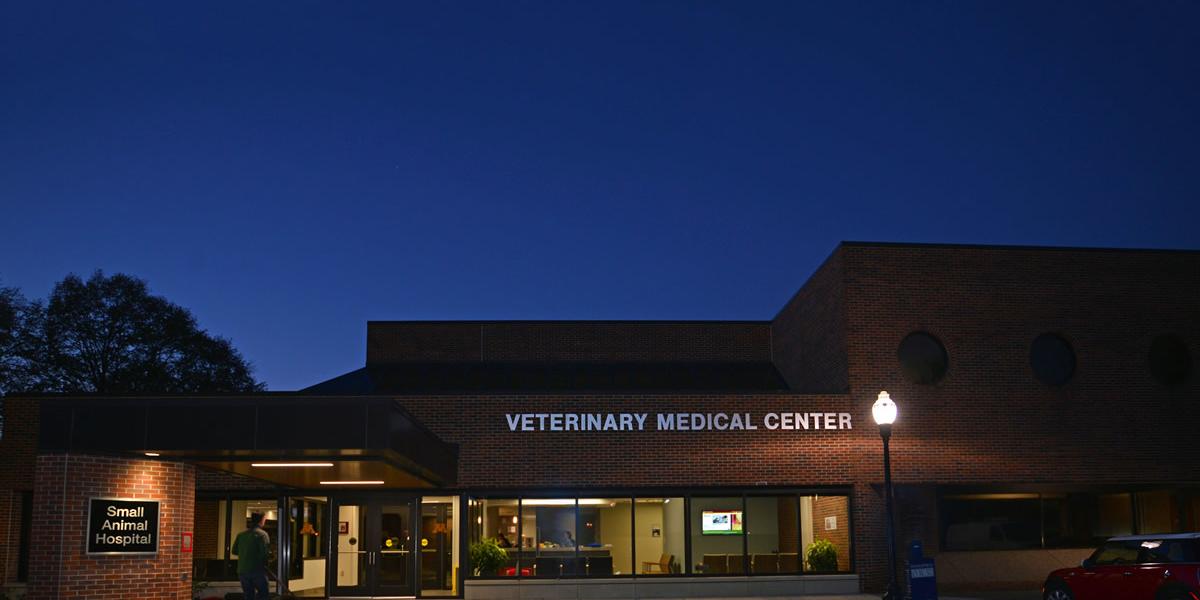The middle ground
Urgent Care service a boon to VMC

Urgent Care service a boon to VMC
Photo by Sue Kirchoff
Spring seemed like a distant dream through April this year at the College of Veterinary Medicine (CVM). But the Veterinary Medical Center’s Urgent Care Service (UC) was ready and waiting. As the snow thawed, drawing pets and their owners back outside, the UC team greeted a fresh flow of patients. As usual, they were prepared to treat the bug bites, bumps, and bruises that accompany more outdoor play. Since opening two-and-a-half years ago, the UC has made it a mission to provide skilled, efficient care for mild illnesses and injuries.
Kendra Dauenhauer, DVM, recently treated Boomer, a Labrador retriever with a lame front paw. After noticing a painful bump on the paw, Dauenhauer and her team ran a full exam. They took X-rays to rule out broken bones and quickly discovered a massive splinter running through Boomer’s paw. The team successfully removed the 2.5-inch wood shard and treated the area to prevent infection. Less than three hours after arriving, Boomer left with his family—a little sore, but lame no longer.
The UC offers worried owners like Boomer’s a helpful middle ground. It serves cats and dogs whose ailments, while not apparent emergencies, are concerning enough to address after normal office hours. Owners seeking preventative care (diet recommendations, for instance) can safely wait to make a regular Primary Care (PC) appointment. Severe cases, such as pets exposed to toxins, should be rushed to Emergency Services (ER). The Urgent Care center, meanwhile, covers just about everything in between. As for owners who simply aren’t sure where their pet belongs? The UC can provide guidance. Its clinicians triage each case quickly and carefully to ensure each patient is exactly where they need to be.
Although UC patients leave the same day they arrive, they remain in the hearts of UC staff long after. Justine Boschee, DVM, remembers treating Felix, a cat brought in for a nosebleed. Felix was already being treated for heart and kidney disease by PC and Cardiology Services when he arrived at Urgent Care. Boschee and her team identified elevated liver enzymes in Felix’s blood work, and they determined his cardiac medications were the cause. Adjusting his medication regimen ended the nosebleeds. However, well after Felix left the UC, Boschee took the time to check in with his owner regularly through phone calls. Together, they discussed Felix’s health and ways of improving his quality of life.
Tucked inside the Veterinary Medical Center (VMC), the UC’s central location within the hospital allows its clinicians to make fast, flexible treatment recommendations, and gives hospital staff the chance to tackle an animal’s health and wellbeing as a whole. Some patients require specialized resources or more critical care. In these cases, further options are right down the hall—the ER is located within the same building. Rather than drive their pet to a new destination, owners can simply stay posted in the VMC waiting room.
The VMC provides other benefits to the UC, too. Urgent Care clinicians have access to the VMC’s radiographic services, and they are able to receive reports after-hours. UC clients can easily use the VMC Pharmacy if needed (like the ER, it’s under the same roof). The Urgent Care also stocks its own after-hours pharmacy. When the main VMC Pharmacy is closed, this “mini pharmacy” provides owners with products and medications commonly prescribed within the UC.
Though small, the core UC team is backed by solid experience and open communication. “Team” is the operative word, as it is the synergy of the experienced staff that ultimately drives the service’s success. Both primary care doctors Boschee and Dauenhauer have ER backgrounds, and their confidence is reflected in the rest of the team, which makes for an encouraging experience for the fourth year CVM students that perform their clinical rotations there. According to Michelle Haralson, CVT, the students are consistently impressed by how nice the staff is to each other. “They hope to experience a similar atmosphere once they’re out in the ‘real world.’”
“Team” is the operative word, as it is the synergy of the experienced staff that ultimately drives the service’s success.
The UC team’s assured, compassionate approach keeps patients coming back—sometimes simply to say hello. Ela the standard poodle was first brought to the UC in 2016. Boschee and her team successfully treated Ela, then just a puppy, for a skin infection. More visits over the next few months made Ela and her owner a favorite duo at the UC. Ela’s owner is one of several that have dropped in just to chat with the team, with or without their pet.
“Over the past two and a half years, we have seen dramatic growth in our department, both within and outside the University community,” said Boschee. And she expects the UC to develop and expand even further. Looking ahead, the team hopes to hire a third vet tech and include full-time CVM students in every shift. Another major goal is to acquire more tools. Topping the team’s wish list is a tonometer, a device used to detect glaucoma. For both the UC and its patients, the future looks bright.
Photo courtesy of Ela's owner, Randy Roberts